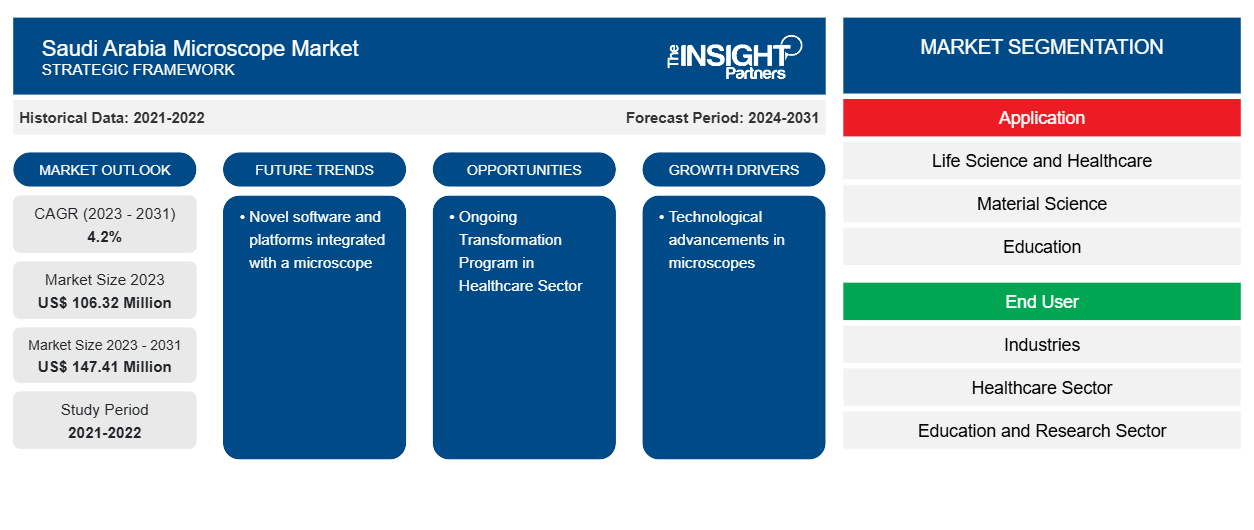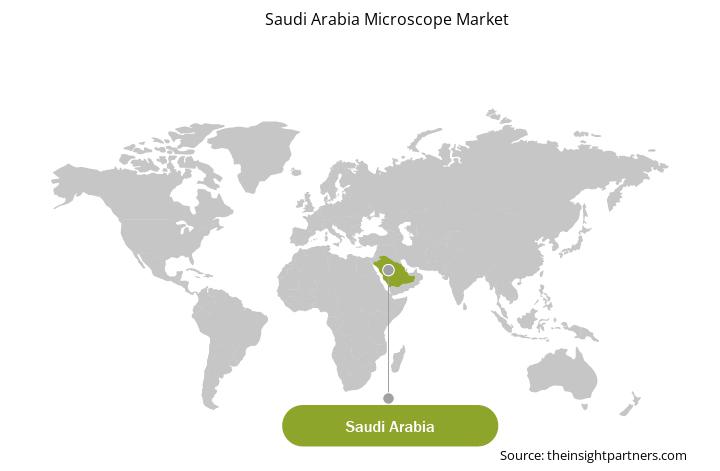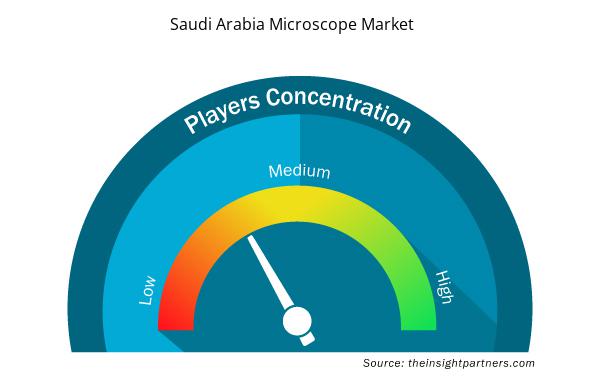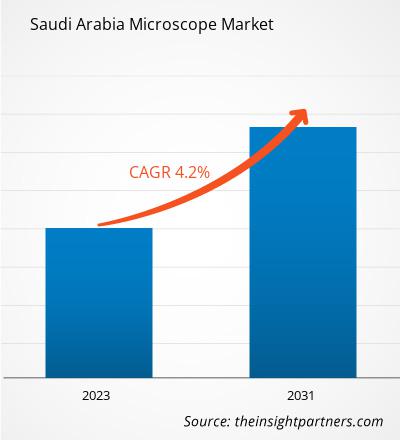Der saudi-arabische Mikroskopmarkt wird voraussichtlich von 106,32 Millionen US-Dollar im Jahr 2023 auf 147,41 Millionen US-Dollar im Jahr 2031 anwachsen. Für den Zeitraum 2023–2031 wird eine durchschnittliche jährliche Wachstumsrate (CAGR) von 4,2 % erwartet. Der Einsatz neuartiger, in Mikroskope integrierter Software und Plattformen dürfte in den kommenden Jahren die wichtigsten Trends sein.
Marktanalyse für Mikroskope in Saudi-Arabien
Zu den Faktoren, die das Marktwachstum unterstützen, zählen der zunehmende technologische Fortschritt bei Mikroskopen sowie moderne Einrichtungen im Gesundheitswesen und in der medizinischen Forschung. Darüber hinaus dürften zunehmende Innovationen in der digitalen Bildgebung und die Integration fortschrittlicher Technologien wie künstlicher Intelligenz die Mikroskopiefähigkeiten verbessern. Darüber hinaus dürften laufende Transformationsprogramme im Gesundheitssektor reichlich Möglichkeiten für das Marktwachstum schaffen.
Marktübersicht für Mikroskope in Saudi-Arabien
Der saudi-arabische Mikroskopmarkt wird durch den rasanten technologischen Fortschritt bei Mikroskopen und die zunehmende Forschungstätigkeit im Gesundheitswesen vorangetrieben. Saudi-Arabien ist die größte Volkswirtschaft im Nahen Osten und zeichnet sich durch das Wachstum verschiedener Forschungs- und Entwicklungsprogramme im ganzen Land aus. Das Land erlangt in der Forschung und Entwicklung zunehmende Bekanntheit. Saudi-Arabien hat sich in jüngster Zeit als Zentrum wissenschaftlicher Exzellenz und Innovation etabliert. Zahlreiche Investitionen in verschiedenen Forschungsbereichen führten zu einem Wissenszuwachs im Gesundheitswesen und in der Wissenschaft sowie zur Umsetzung der Erkenntnisse für neue Anwendungen und Projekte. Diese Investitionen in das Gesundheitswesen und die Wissenschaft treiben den Mikroskopmarkt in Saudi-Arabien voran.
Darüber hinaus berichtete das Saudi Arabia Cancer Observatory (GCO) im Jahr 2020, dass Krebs im Land weit verbreitet ist. Brustkrebs, Dickdarmkrebs, Gebärmutterkrebs, Schilddrüsenkrebs, Prostatakrebs, Non-Hodgkin-Lymphom, Leukämie, Leberkrebs, Lungenkrebs und Eierstockkrebs sind die häufigsten Todesursachen im Land. Der Mikroskopmarkt in Saudi-Arabien wird durch die zunehmende Anwendung von Mikroskopen in der Krebsforschung angetrieben. Darüber hinaus werden Mikroskope zum Scannen und Erkennen von Tumoren in menschlichen Zellen eingesetzt. Diese Faktoren treiben die Nachfrage nach Mikroskopen im Land an.
Passen Sie diesen Bericht Ihren Anforderungen an
Sie erhalten kostenlos Anpassungen an jedem Bericht, einschließlich Teilen dieses Berichts oder einer Analyse auf Länderebene, eines Excel-Datenpakets sowie tolle Angebote und Rabatte für Start-ups und Universitäten
Mikroskopmarkt in Saudi-Arabien:

- Informieren Sie sich über die wichtigsten Markttrends in diesem Bericht.Dieses KOSTENLOSE Beispiel umfasst eine Datenanalyse, die von Markttrends bis hin zu Schätzungen und Prognosen reicht.
Treiber und Chancen des Mikroskopmarktes in Saudi-Arabien
Technologische Fortschritte bei Mikroskopen
Die Mikroskoptechnologie hat sich über Jahrhunderte enorm weiterentwickelt. Jüngste Fortschritte in der Digitaltechnik haben zur Einführung digitaler Mikroskope geführt, die die aufgenommenen Bilder in Echtzeit auf einem Computermonitor darstellen. Diese Mikroskope sind ergonomisch, da die Probe nicht durch das Okular betrachtet werden muss; stattdessen werden die Bilder auf dem Bildschirm angezeigt und können mit höherer Vergrößerung als bei herkömmlichen Mikroskopen betrachtet werden. Die Digitalmikroskopie liegt im Trend und bietet eine höhere Bildauflösung und Präzision, was zu weniger verzerrten Bildern und einer besseren Betrachtung der Proben führt. Die Verbreitung der Digitalmikroskopie wurde durch die Entwicklung von Ganzkörper-Scansystemen beschleunigt. Dieses System bietet eine detaillierte Visualisierung von Proben mit 2D- und 3D-Bildern für Forschung und Entwicklung, Qualitätskontrolle, Forensik und Fehleranalyse.
Technologische Fortschritte bei Mikroskopen umfassen die Bildgebung lebender Zellen, Digitalisierung, Hochdurchsatzverfahren und Superauflösung. Zu den jüngsten Entwicklungen zählen die Raster-Helium-Mikroskopie (SHeM), das Expansionsmikroskop, integrierte Mikroskopie-Workflows und das Mehransichtsmikroskop.digitalization, high throughput methods, and super-resolution. Recent developments include Scanning helium microscopy (SHeM), expansion microscope, integrated microscopy workflows, and multi-view microscope.
Laufendes Transformationsprogramm im Gesundheitssektor
Der anhaltende Wandel im Gesundheitswesen im Rahmen der Saudi Vision 2030 zur Verbesserung der Gesundheitsversorgung hat die Nachfrage nach verschiedenen Mikroskoptypen sowie anderen Diagnoseinstrumenten und -geräten erhöht. Mikroskope gehören zu den wichtigsten Instrumenten in verschiedenen medizinischen Bereichen, darunter Pathologie , Mikrobiologie, Hämatologie sowie Forschung und Entwicklung.
Laut der Internationalen Handelsbehörde (ITA) entfielen im Jahr 2022 rund 60 % der Gesundheitsausgaben der Länder des Golf-Kooperationsrates (GCC) auf Saudi-Arabien. Das Land wird voraussichtlich rund 50,4 Milliarden US-Dollar in den Gesundheitssektor investieren, um die medizinische Versorgung zu verbessern und Forschung und Innovation zu fördern. Dies dürfte lukrative Möglichkeiten für Hersteller und Lieferanten von Mikroskopen schaffen, um den wachsenden Bedarf im saudi-arabischen Gesundheitswesen zu decken.
Saudi-Arabien Mikroskop Marktbericht Segmentierungsanalyse
Wichtige Segmente, die zur Ableitung der Mikroskopmarktanalyse in Saudi-Arabien beigetragen haben, sind Anwendung und Endbenutzer.
- Der saudi-arabische Mikroskopmarkt ist nach Anwendungsbereichen in die Bereiche Biowissenschaften und Gesundheitswesen, Materialwissenschaften, Bildung, Forschung und Entwicklung sowie Halbleiter unterteilt. Das Segment Biowissenschaften und Gesundheitswesen hatte 2023 den größten Marktanteil und wird voraussichtlich zwischen 2023 und 2031 die höchste durchschnittliche jährliche Wachstumsrate (CAGR) verzeichnen.
- Der saudi-arabische Mikroskopmarkt ist nach Endverbraucher in die Branchen Industrie, Gesundheitswesen sowie Bildungs- und Forschungssektor segmentiert. Das Industriesegment dominierte den Markt im Jahr 2023, und das Gesundheitssegment wird voraussichtlich zwischen 2023 und 2031 die höchste durchschnittliche jährliche Wachstumsrate (CAGR) verzeichnen.
Saudi-Arabien-Mikroskop
Regionale Einblicke in den Mikroskopmarkt in Saudi-Arabien
Die regionalen Trends und Faktoren, die den saudi-arabischen Mikroskopmarkt im Prognosezeitraum beeinflussen, wurden von den Analysten von Insight Partners ausführlich erläutert. Dieser Abschnitt behandelt auch die Marktsegmente und die geografische Lage des saudi-arabischen Mikroskopmarktes in Nordamerika, Europa, Asien-Pazifik, dem Nahen Osten und Afrika sowie Süd- und Mittelamerika.

- Erhalten Sie regionale Daten zum Mikroskopmarkt in Saudi-Arabien
Umfang des Marktberichts für Mikroskope in Saudi-Arabien
| Berichtsattribut | Details |
|---|---|
| Marktgröße im Jahr 2023 | 106,32 Millionen US-Dollar |
| Marktgröße bis 2031 | 147,41 Millionen US-Dollar |
| Globale CAGR (2023 – 2031) | 4,2 % |
| Historische Daten | 2021-2022 |
| Prognosezeitraum | 2024–2031 |
| Abgedeckte Segmente | Nach Anwendung
|
| Abgedeckte Regionen und Länder | Saudi-Arabien
|
| Marktführer und wichtige Unternehmensprofile |
|
Dichte der Marktteilnehmer für Mikroskope in Saudi-Arabien: Auswirkungen auf die Geschäftsdynamik
Der saudi-arabische Mikroskopmarkt wächst rasant. Die steigende Nachfrage der Endverbraucher ist auf Faktoren wie veränderte Verbraucherpräferenzen, technologische Fortschritte und ein stärkeres Bewusstsein für die Produktvorteile zurückzuführen. Mit der steigenden Nachfrage erweitern Unternehmen ihr Angebot, entwickeln Innovationen, um den Bedürfnissen der Verbraucher gerecht zu werden, und nutzen neue Trends, was das Marktwachstum weiter ankurbelt.
Die Marktteilnehmerdichte beschreibt die Verteilung der in einem bestimmten Markt oder einer bestimmten Branche tätigen Unternehmen. Sie gibt an, wie viele Wettbewerber (Marktteilnehmer) in einem bestimmten Marktraum im Verhältnis zu dessen Größe oder Gesamtmarktwert präsent sind.
Die wichtigsten Unternehmen auf dem Mikroskopmarkt in Saudi-Arabien sind:
- Nikon Corp,
- Leica Microsystems,
- Carl Zeiss AG,
- Olympus Corp.
Haftungsausschluss : Die oben aufgeführten Unternehmen sind nicht in einer bestimmten Reihenfolge aufgeführt.

- Verschaffen Sie sich einen Überblick über die wichtigsten Akteure auf dem saudi-arabischen Mikroskopmarkt
Marktbericht zu Mikroskopen in Saudi-Arabien: Umfang und Ergebnisse
Der Bericht „Marktgröße und Prognose des Mikroskopmarkts in Saudi-Arabien (2021–2031)“ bietet eine detaillierte Analyse des Marktes, die die folgenden Bereiche abdeckt:
- Marktgröße und Prognose des Mikroskopmarktes in Saudi-Arabien auf Länderebene für alle wichtigen Marktsegmente, die im Rahmen des Geltungsbereichs abgedeckt sind
- Markttrends und Marktdynamiken für Mikroskope in Saudi-Arabien, darunter Treiber, Einschränkungen und wichtige Chancen
- Detaillierte PEST- und SWOT-Analyse
- Marktanalyse für Mikroskope in Saudi-Arabien mit wichtigen Markttrends und regionalen Rahmenbedingungen, wichtigen Akteuren, Vorschriften und aktuellen Marktentwicklungen
- Branchenlandschafts- und Wettbewerbsanalyse mit Marktkonzentration, Heatmap-Analyse, prominenten Akteuren und jüngsten Entwicklungen für den Mikroskopmarkt in Saudi-Arabien
- Detaillierte Firmenprofile
- Historische Analyse (2 Jahre), Basisjahr, Prognose (7 Jahre) mit CAGR
- PEST- und SWOT-Analyse
- Marktgröße Wert/Volumen – Global, Regional, Land
- Branche und Wettbewerbsumfeld
- Excel-Datensatz



Report Coverage
Revenue forecast, Company Analysis, Industry landscape, Growth factors, and Trends

Segment Covered
This text is related
to segments covered.

Regional Scope
North America, Europe, Asia Pacific, Middle East & Africa, South & Central America

Country Scope
This text is related
to country scope.
Häufig gestellte Fragen
Microscopes are instruments used to observe small objects that are too small for naked eyes. Microscopes have applications in various industries including healthcare, semiconductors, research, material science and others. Saudi Arabia microscope market growth is attributed to the increasing investments in the fields of research and development alongside ever-expanding educational activities and growing attention to health innovations.
The Saudi Arabia microscope market is expected to be valued at US$ 147.41 million by 2031.
The Saudi Arabia microscope market was valued at US$ 106.32 million in 2023.
The Saudi Arabia microscope market, by application, is segmented into life sciences and healthcare, material sciences, education, research and development, and semiconductor. In 2023, the life sciences and healthcare segment held a larger share of the market and is expected to register a higher CAGR in the market during 2023–2031.
The Saudi Arabia microscope market majorly consists of the players, including Nikon Corp, Leica Microsystems, Carl Zeiss AG, and Olympus Corp
The factors driving the growth of the Saudi Arabia microscope market include the technological advancements in microscopes and advanced healthcare and medical research facilities. However, high prices of technologically advanced microscopes hamper the growth of the Saudi Arabia microscope market.
Trends and growth analysis reports related to Life Sciences : READ MORE..
The List of Companies - Saudi Arabia Microscope Market
- Nikon Corp
- Leica Microsystems
- Carl Zeiss AG
- Olympus Corp.
The Insight Partners performs research in 4 major stages: Data Collection & Secondary Research, Primary Research, Data Analysis and Data Triangulation & Final Review.
- Data Collection and Secondary Research:
As a market research and consulting firm operating from a decade, we have published and advised several client across the globe. First step for any study will start with an assessment of currently available data and insights from existing reports. Further, historical and current market information is collected from Investor Presentations, Annual Reports, SEC Filings, etc., and other information related to company’s performance and market positioning are gathered from Paid Databases (Factiva, Hoovers, and Reuters) and various other publications available in public domain.
Several associations trade associates, technical forums, institutes, societies and organization are accessed to gain technical as well as market related insights through their publications such as research papers, blogs and press releases related to the studies are referred to get cues about the market. Further, white papers, journals, magazines, and other news articles published in last 3 years are scrutinized and analyzed to understand the current market trends.
- Primary Research:
The primarily interview analysis comprise of data obtained from industry participants interview and answers to survey questions gathered by in-house primary team.
For primary research, interviews are conducted with industry experts/CEOs/Marketing Managers/VPs/Subject Matter Experts from both demand and supply side to get a 360-degree view of the market. The primary team conducts several interviews based on the complexity of the markets to understand the various market trends and dynamics which makes research more credible and precise.
A typical research interview fulfils the following functions:
- Provides first-hand information on the market size, market trends, growth trends, competitive landscape, and outlook
- Validates and strengthens in-house secondary research findings
- Develops the analysis team’s expertise and market understanding
Primary research involves email interactions and telephone interviews for each market, category, segment, and sub-segment across geographies. The participants who typically take part in such a process include, but are not limited to:
- Industry participants: VPs, business development managers, market intelligence managers and national sales managers
- Outside experts: Valuation experts, research analysts and key opinion leaders specializing in the electronics and semiconductor industry.
Below is the breakup of our primary respondents by company, designation, and region:

Once we receive the confirmation from primary research sources or primary respondents, we finalize the base year market estimation and forecast the data as per the macroeconomic and microeconomic factors assessed during data collection.
- Data Analysis:
Once data is validated through both secondary as well as primary respondents, we finalize the market estimations by hypothesis formulation and factor analysis at regional and country level.
- Macro-Economic Factor Analysis:
We analyse macroeconomic indicators such the gross domestic product (GDP), increase in the demand for goods and services across industries, technological advancement, regional economic growth, governmental policies, the influence of COVID-19, PEST analysis, and other aspects. This analysis aids in setting benchmarks for various nations/regions and approximating market splits. Additionally, the general trend of the aforementioned components aid in determining the market's development possibilities.
- Country Level Data:
Various factors that are especially aligned to the country are taken into account to determine the market size for a certain area and country, including the presence of vendors, such as headquarters and offices, the country's GDP, demand patterns, and industry growth. To comprehend the market dynamics for the nation, a number of growth variables, inhibitors, application areas, and current market trends are researched. The aforementioned elements aid in determining the country's overall market's growth potential.
- Company Profile:
The “Table of Contents” is formulated by listing and analyzing more than 25 - 30 companies operating in the market ecosystem across geographies. However, we profile only 10 companies as a standard practice in our syndicate reports. These 10 companies comprise leading, emerging, and regional players. Nonetheless, our analysis is not restricted to the 10 listed companies, we also analyze other companies present in the market to develop a holistic view and understand the prevailing trends. The “Company Profiles” section in the report covers key facts, business description, products & services, financial information, SWOT analysis, and key developments. The financial information presented is extracted from the annual reports and official documents of the publicly listed companies. Upon collecting the information for the sections of respective companies, we verify them via various primary sources and then compile the data in respective company profiles. The company level information helps us in deriving the base number as well as in forecasting the market size.
- Developing Base Number:
Aggregation of sales statistics (2020-2022) and macro-economic factor, and other secondary and primary research insights are utilized to arrive at base number and related market shares for 2022. The data gaps are identified in this step and relevant market data is analyzed, collected from paid primary interviews or databases. On finalizing the base year market size, forecasts are developed on the basis of macro-economic, industry and market growth factors and company level analysis.
- Data Triangulation and Final Review:
The market findings and base year market size calculations are validated from supply as well as demand side. Demand side validations are based on macro-economic factor analysis and benchmarks for respective regions and countries. In case of supply side validations, revenues of major companies are estimated (in case not available) based on industry benchmark, approximate number of employees, product portfolio, and primary interviews revenues are gathered. Further revenue from target product/service segment is assessed to avoid overshooting of market statistics. In case of heavy deviations between supply and demand side values, all thes steps are repeated to achieve synchronization.
We follow an iterative model, wherein we share our research findings with Subject Matter Experts (SME’s) and Key Opinion Leaders (KOLs) until consensus view of the market is not formulated – this model negates any drastic deviation in the opinions of experts. Only validated and universally acceptable research findings are quoted in our reports.
We have important check points that we use to validate our research findings – which we call – data triangulation, where we validate the information, we generate from secondary sources with primary interviews and then we re-validate with our internal data bases and Subject matter experts. This comprehensive model enables us to deliver high quality, reliable data in shortest possible time.

 Holen Sie sich ein kostenloses Muster für diesen Bericht
Holen Sie sich ein kostenloses Muster für diesen Bericht